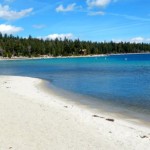Lake Tahoe clarity improves substantially
Drought is a good thing for Lake Tahoe’s clarity.
This was proved with today’s announcement that the largest gain in clarity in more than a decade occurred in 2014. A disc that looks like a white dinner plate could be seen to a depth of 77.8 feet, an increase of 7.5 feet.
The Secchi disk has been used for decades to measure lake clarity. It’s dropped over the side of a boat at various locations and then someone eyeballs how far they can clearly see it. The deepest point was 93.5 feet on July 7, and the lowest was 57.4 feet on Sept. 16.

Annual average clarity readings since 1997:
• 2014: 77.8 feet
• 2013: 70.2 feet
• 2012: 75.3 feet
• 2011: 68.9 feet
• 2010: 64.4 feet
• 2009: 68.1 feet
• 2008: 69.6 feet
• 2007: 70.1 feet
• 2006: 67.7 feet
• 2005: 72.4 feet
• 2004: 73.6 feet
• 2003: 71 feet
• 2002: 78 feet
• 2001: 73.6 feet
• 2000: 67.3 feet
• 1999: 69 feet
• 1998: 66.1 feet
• 1997: 64.1 feet
Source: TERC
“While these latest data are very reassuring, they should not be interpreted as victory in our joint restoration efforts,” Geoff Schladow, director of the UC Davis Tahoe Environmental Research Center, said in a statement. “Complete restoration is still decades away, and some of the greatest challenges still lie ahead of us. We are enduring drier and warmer conditions than we have ever encountered, and the restoration consequences of that are still far from understood.”
In light winters there is less runoff into the lake. This means less sediment to cloud the water. Warmer temps also means the lake water is mixing less; this also is good for clarity. (It also brings a whole different set of ecological issues.)
Researchers provided measurements for winter (December–March) and summer (June–September). Winter clarity last year improved by 1 foot. The winter average of 78.7 feet was well above the worst winter average, 66.6 feet seen in 1997. The largest improvement was seen in summer clarity, where there was a 13-foot improvement over the preceding year. At 78.7 feet this is the highest value since 2002.
Scientists are also giving credit for the improvement to the entities working to curtail sediments from reaching the lake. This is through the total maximum daily load and environmental improvement programs. More than $1 billion has been spent in the last decade on projects related to Lake Tahoe’s clarity.
In 1968, the disk could be seen to 102.4 feet. Efforts are under way to get back to that level, but it’s not expected to happen for more than a half century.
— Lake Tahoe News staff report